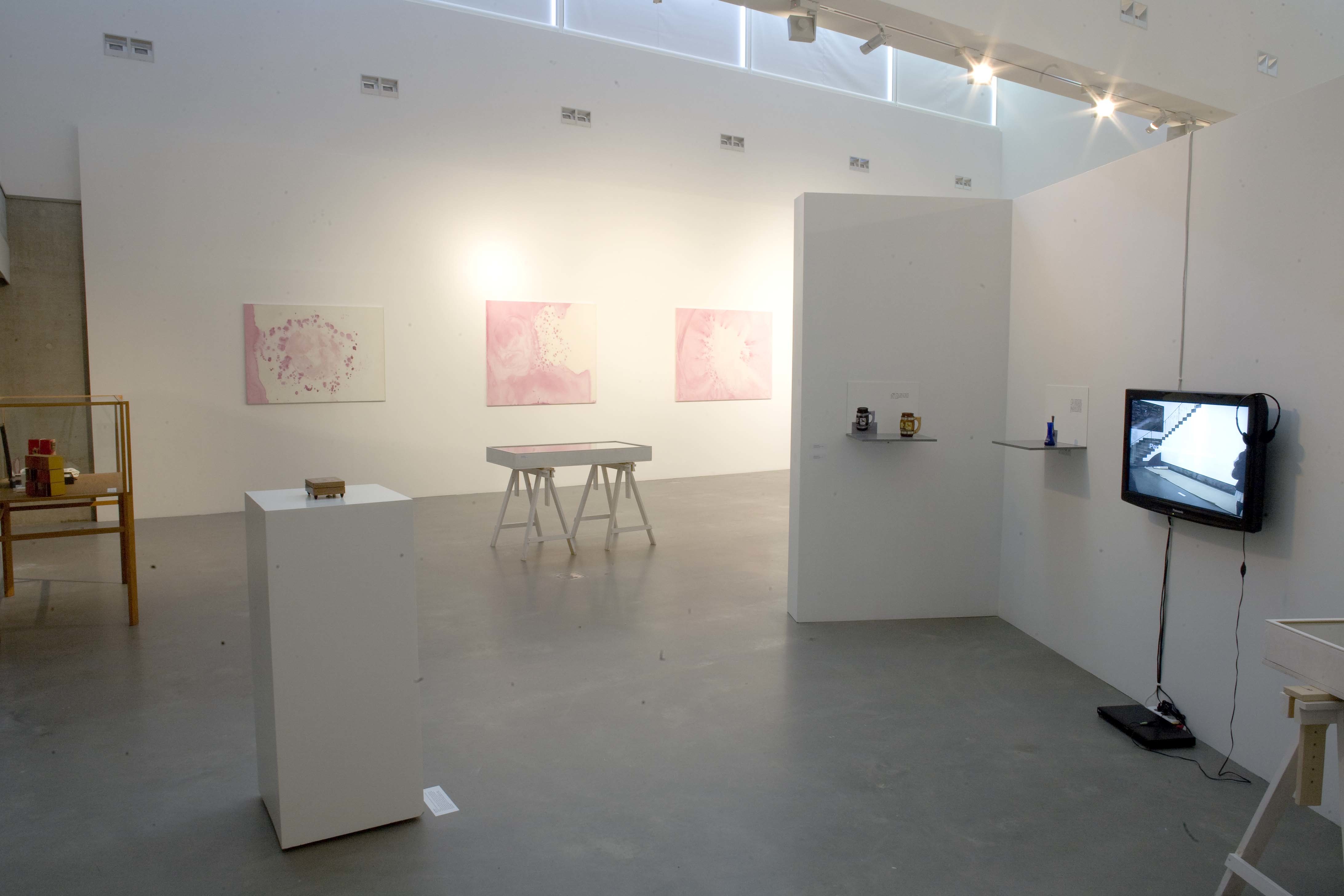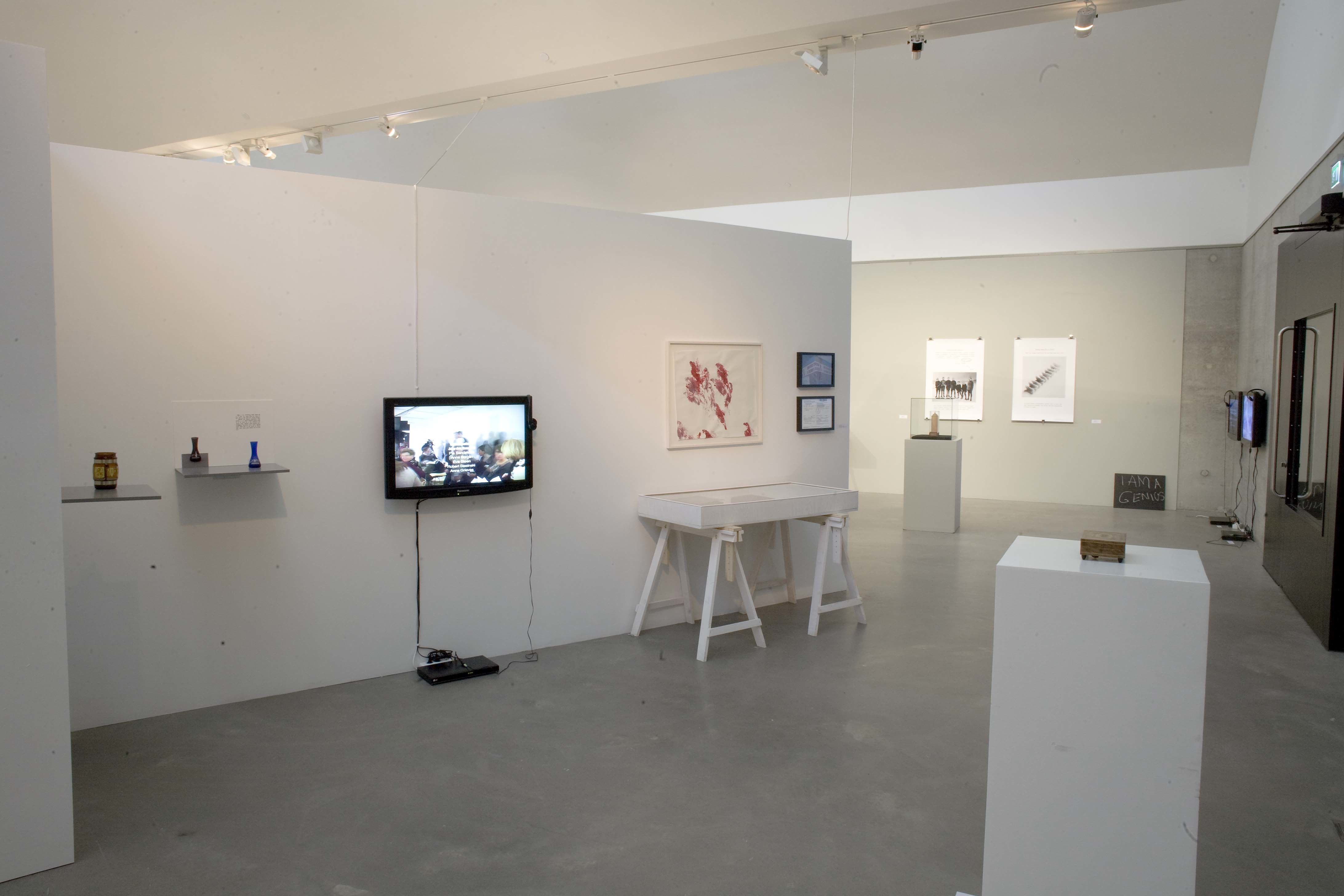Swedish Conceptual Art, Kalmar Konstmuseum
SVENSK KONCEPTKONST / SWEDISH CONCEPTUAL ARTSeptember 4 – November 14, 2010
KALMAR KONSTMUSEUM
Showing: Black Box #4, An attempt to deal with the measurements of capacity, and to activate negative volumes. Containing the six different materials of a dismantled couch, carefully sorted and placed on top of each other according to density, with the lightest layer at the bottom. Some metal parts have been removed, but this has been compensated for with expanding foam. The box is disguised as a standard white museum pedestal and is presented with another artist’s work on top of it.
Download catalogue pdf here










Text by the curators:
"The exhibition Swedish Conceptual Art examines the role of conceptual art in the history of art in Sweden. What has it meant? Where does it stand today? Is there even anything that could be considered “Swedish conceptual art”?
The first Swedish examples that may be categorized as conceptual art appeared as early as the 1950s and early 60s in the work of Carl Fredrik Reutersvärd and Erik Dietman. However, conceptual art did not play a prominent role in the Swedish art scene, but existed more or less as an underground movement. It is noteworthy that conceptual art was not spread by the country’s art institutions, but rather through the efforts of individual artists and ever-changing groups of artists striving to generate interest in their work. Publishers such as Bo Cavefors and Kalejdoskop played an important role in its spread by publishing and distributing artists’ books, sound works, and articles about conceptual art. Indirectly this contributed to the concentration of conceptual art to islands of growing interest, including Skåne County, where the Galleri S:t Petri in Lund, for example, introduced a series of significant artists to the Swedish public.
Our idea is for this exhibition to serve as an introduction to Swedish conceptual art. It may be seen in part as a contribution to the continuing discussion of conceptual art’s importance to the history of art in Sweden. A number of questions will be addressed: What is conceptual art?
Contributing artists:
Mette Aarre, Bengt Adlers, Mats B, Beck & Jung, Ola Billgren, Conny Blom, Pierre Brassau, Magnus Bärtås, Rolf Börjlind, Juan Castillo, Åsa Cederqvist, Kajsa Dahlberg, Erik Dietman, Alessandra Di Pisa, Andjeas Ejiksson, Leif Elggren, Leif Eriksson, Öjvind Fahlström, Juan Pedro Fabra Guemberena, Dan Fröberg, Jörgen Gassilewski, Andreas Gedin, Sten Hanson, Karin Hasselberg, Carl Michael von Hausswolff, Gustav Hillbom, Åke Hodell, Karl Holmqvist, Susanne Högberg, Sture Johannesson, Mathias Josefson, Robert Jäppinen, Bengt af Klintberg, Beth Laurin, Thomas Liljenberg, Maria Lindberg, Anna Lundh, LG Lundberg, Björn Lövin, Carl Magnus, Jonas (J) Magnusson and Cecilia Grönberg, J O Mallander, Sven Malvin, Annelie Nilsson, Ulf Karl Olov Nilsson, Jesper Norda, Magdalena Nordin and Ulrika Westergren, Max Ockborn, Peter Ortman, Erik Pauser, Juan Carlos Peirone, Lina Persson, Berndt Petterson, Carl Fredrik Reuterswärd, Roger von Reybekiel, Bengt Rooke, Kjartan Slettemark, Vassil Simittchiev, Johan Strandahl, Annika Ström, Carl-Erik Ström, Jan Svenungsson, Pär Thörn, Lars Vilks, Grant Watkins, Ulla West, Elin Wikström, Dan Wolgers, and more.
Curators: Martin Schibli & Bengt Olof Johansson
Assisting Curator: Oscar Guermouche
Coordinator: Malin Nilsson
"The exhibition Swedish Conceptual Art examines the role of conceptual art in the history of art in Sweden. What has it meant? Where does it stand today? Is there even anything that could be considered “Swedish conceptual art”?
The first Swedish examples that may be categorized as conceptual art appeared as early as the 1950s and early 60s in the work of Carl Fredrik Reutersvärd and Erik Dietman. However, conceptual art did not play a prominent role in the Swedish art scene, but existed more or less as an underground movement. It is noteworthy that conceptual art was not spread by the country’s art institutions, but rather through the efforts of individual artists and ever-changing groups of artists striving to generate interest in their work. Publishers such as Bo Cavefors and Kalejdoskop played an important role in its spread by publishing and distributing artists’ books, sound works, and articles about conceptual art. Indirectly this contributed to the concentration of conceptual art to islands of growing interest, including Skåne County, where the Galleri S:t Petri in Lund, for example, introduced a series of significant artists to the Swedish public.
Our idea is for this exhibition to serve as an introduction to Swedish conceptual art. It may be seen in part as a contribution to the continuing discussion of conceptual art’s importance to the history of art in Sweden. A number of questions will be addressed: What is conceptual art?
Contributing artists:
Mette Aarre, Bengt Adlers, Mats B, Beck & Jung, Ola Billgren, Conny Blom, Pierre Brassau, Magnus Bärtås, Rolf Börjlind, Juan Castillo, Åsa Cederqvist, Kajsa Dahlberg, Erik Dietman, Alessandra Di Pisa, Andjeas Ejiksson, Leif Elggren, Leif Eriksson, Öjvind Fahlström, Juan Pedro Fabra Guemberena, Dan Fröberg, Jörgen Gassilewski, Andreas Gedin, Sten Hanson, Karin Hasselberg, Carl Michael von Hausswolff, Gustav Hillbom, Åke Hodell, Karl Holmqvist, Susanne Högberg, Sture Johannesson, Mathias Josefson, Robert Jäppinen, Bengt af Klintberg, Beth Laurin, Thomas Liljenberg, Maria Lindberg, Anna Lundh, LG Lundberg, Björn Lövin, Carl Magnus, Jonas (J) Magnusson and Cecilia Grönberg, J O Mallander, Sven Malvin, Annelie Nilsson, Ulf Karl Olov Nilsson, Jesper Norda, Magdalena Nordin and Ulrika Westergren, Max Ockborn, Peter Ortman, Erik Pauser, Juan Carlos Peirone, Lina Persson, Berndt Petterson, Carl Fredrik Reuterswärd, Roger von Reybekiel, Bengt Rooke, Kjartan Slettemark, Vassil Simittchiev, Johan Strandahl, Annika Ström, Carl-Erik Ström, Jan Svenungsson, Pär Thörn, Lars Vilks, Grant Watkins, Ulla West, Elin Wikström, Dan Wolgers, and more.
Curators: Martin Schibli & Bengt Olof Johansson
Assisting Curator: Oscar Guermouche
Coordinator: Malin Nilsson
Must a work be generated exclusively by a concept or idea for it to be considered conceptual? To what extent is conceptual art based on writing and language? What is the relationship between conceptual art and the Fluxus movement? Was conceptual art in Sweden related to that of other countries? The exhibition includes references that may be traced to a variety of foreign sources, including Robert Filou in France, Joseph Beuys in Germany, and John Cage and Joseph Kosuth in the United States. There are also connections with South American conceptual art. Some of the works are definitely humorous, while others are more philosophically intricate. Some artists are conceptual purists whose subjects are ideas as it were in isolation, while others’ works admit of outside influences and references.
For the most part the exhibition consists of works on loan from individual artists, private collectors, and museums, but it also includes some pieces from Kalmar konstmuseum’s own collection. Over sixty artists are represented in the exhibition, with works dating from the 1950s to the present. There has not been room for all of the artists who would belong in a historical exposition of conceptual art, and a few have declined to participate in the exhibition. Neither has it been possible to give an authoritative presentation of each and every artist. Due to the limitations of gallery space, some pieces that deserve to be included have not been. Rather than attempting to present a complete historical description, our hope is to be able to illuminate one thread in the history of Swedish art. In many ways, this exhibition may be seen as a work in progress. That work will continue even after the opening, with more to come during the course of the exhibition, including lectures and performances, and there will be an exhibition catalogue."
For the most part the exhibition consists of works on loan from individual artists, private collectors, and museums, but it also includes some pieces from Kalmar konstmuseum’s own collection. Over sixty artists are represented in the exhibition, with works dating from the 1950s to the present. There has not been room for all of the artists who would belong in a historical exposition of conceptual art, and a few have declined to participate in the exhibition. Neither has it been possible to give an authoritative presentation of each and every artist. Due to the limitations of gallery space, some pieces that deserve to be included have not been. Rather than attempting to present a complete historical description, our hope is to be able to illuminate one thread in the history of Swedish art. In many ways, this exhibition may be seen as a work in progress. That work will continue even after the opening, with more to come during the course of the exhibition, including lectures and performances, and there will be an exhibition catalogue."